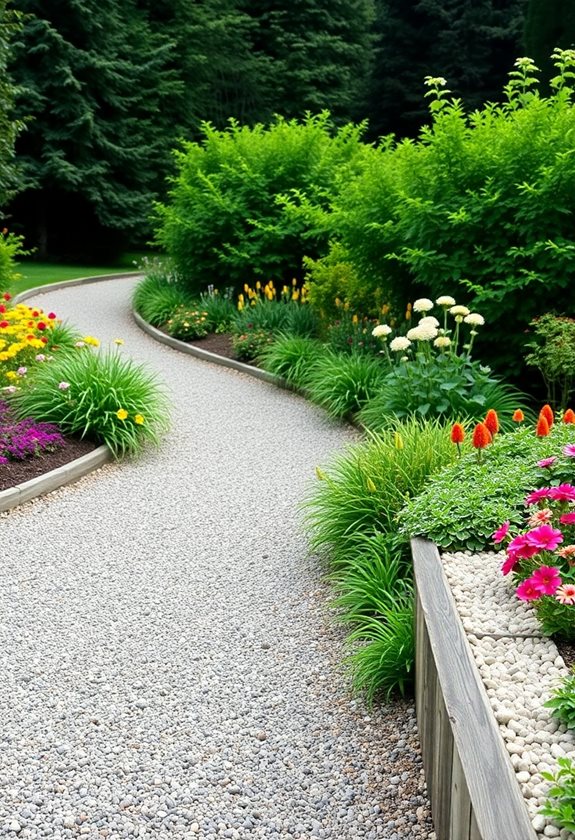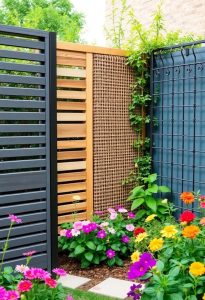Looking to add charm to your garden pathways? Here are three simple ideas that are sure to inspire you! First, consider a gravel pathway; it’s affordable, drains well, and adds a delightful crunch underfoot. Next, try wooden boardwalks for a rustic vibe that blends beautifully with nature. Finally, stone stepping stones create a classic, timeless look while guiding the way through your garden. Ready to transform your outdoor space? There’s so much more to explore!
Design Highlights
- Create a gravel pathway for an affordable, versatile option that offers excellent drainage and a delightful crunch underfoot.
- Construct a wooden boardwalk for a natural aesthetic that withstands the elements, perfect for wet areas or rustic vibes.
- Use stone stepping stones to create a timeless and inviting garden path, surrounded by greenery for a lush look.
- Incorporate eco-friendly materials like gravel to enhance sustainability while promoting natural water flow and reducing erosion.
- Enhance pathways with accessories like garden trellises or potted plants along edges for added beauty and functionality.
Gravel Pathways: Affordable and Versatile
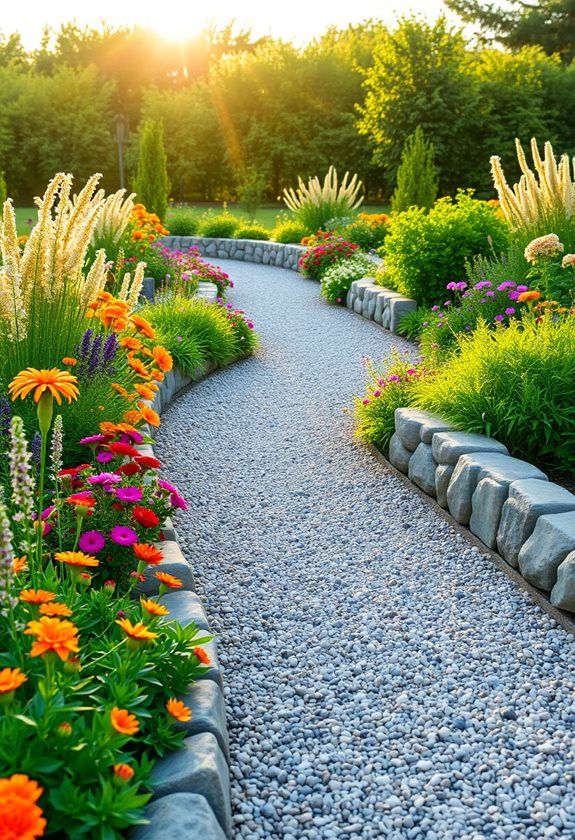
When you think about creating a pathway in your garden, have you ever considered how gravel might be the perfect solution? It’s affordable, versatile, and surprisingly stylish! Imagine walking along a path that crunches underfoot, adding a delightful sensory experience. Plus, gravel allows for excellent drainage—no more muddy shoes!
Consider gravel for your garden pathway—it’s stylish, affordable, and offers delightful crunch underfoot while ensuring excellent drainage!
To start:
- Choose your gravel size—small for a smooth stroll or larger for texture.
- Outline your path with landscaping fabric to keep weeds at bay.
- Fill in with gravel and compact it down.
Trust me, you’ll love the rustic charm and practicality it brings to your garden oasis! Additionally, incorporating eco-friendly options like gravel not only enhances your garden’s aesthetics but also contributes to sustainable landscaping practices.
Wooden Boardwalks: Natural Charm for Your Garden
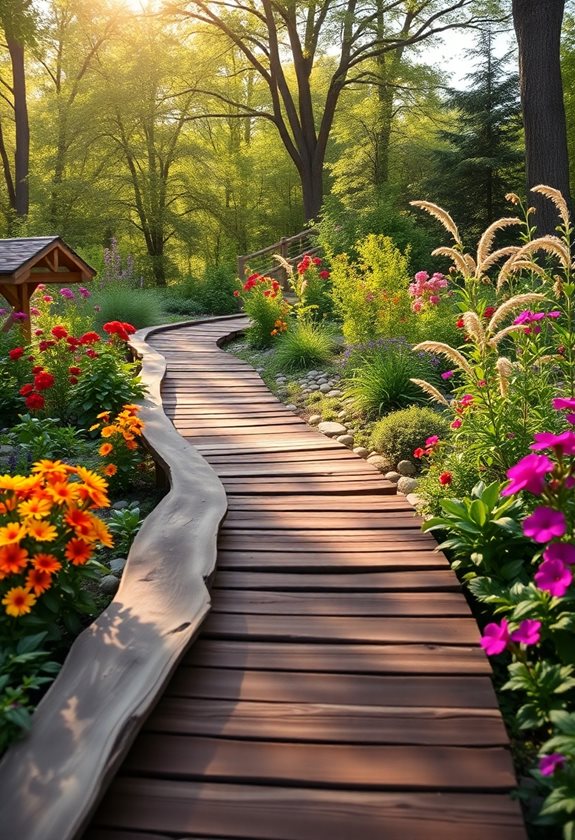
Forget the gravel crunching under your feet for a moment—let’s talk about something that brings a different kind of warmth to your garden: wooden boardwalks. Imagine strolling above the soil, surrounded by lush greenery! Here’s why you should consider them:
- Natural Aesthetics: They blend seamlessly with nature.
- Durability: With proper care, they withstand the elements.
- Versatility: Perfect for wet areas or creating a rustic vibe.
Building one isn’t hard. Just lay down treated planks, secure them, and enjoy! Why not add some potted plants along the edges? Your garden will thank you! Additionally, consider integrating garden trellises to enhance vertical growth and support your climbing plants.
Stone Stepping Stones: A Classic Touch
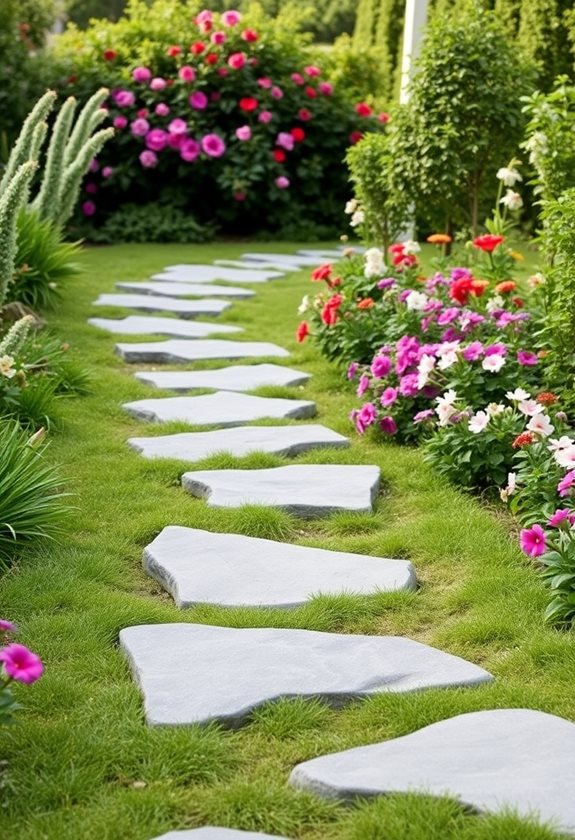
Imagine stepping through your garden on a path that feels both timeless and inviting—stone stepping stones can give you just that experience! They’re not just functional; they add character and charm. Plus, they’re durable and weather-resistant, making them a smart choice for any garden enthusiast. To ensure longevity, consider the material durability and longevity of the stones you choose.
Consider these tips for using stone stepping stones effectively:
- Choose the Right Size: Go for stones that complement your garden’s scale.
- Create a Natural Flow: Place them in a way that guides the eye and foot.
- Add Greenery: Surround them with plants for a lush, inviting look.
Ready to create your masterpiece?
Frequently Asked Questions
What Tools Do I Need to Install Garden Pathways?
When you’re ready to install garden pathways, you’ll need a few essential tools! Grab a shovel for digging, a rake to smooth out the soil, and a level to guarantee everything’s even. Don’t forget a rubber mallet for securing stones or pavers and a measuring tape for accuracy. If you’ve got a wheelbarrow, it’ll make hauling materials a breeze! With these tools, you’re set to create a stunning pathway that’ll impress everyone!
How Do I Maintain My Garden Pathways?
Maintaining your garden pathways is essential for keeping them inviting and functional. Start by regularly sweeping away debris—trust me, it makes a difference! If you notice any weeds, pull them out before they take over. Consider reapplying mulch or gravel every season to keep it fresh. And hey, don’t forget to check for cracks or uneven stones; a little repair work now can prevent bigger headaches later. Isn’t gardening just the best?
Can I Create Pathways on a Slope?
Creating pathways on a slope can feel like climbing Everest, but you can totally conquer it! First, consider using durable materials like gravel or stones, which provide stability. Then, shape the path with gentle curves to enhance aesthetics and safety. Adding steps or retaining walls can also help manage steep areas. Have you thought about incorporating plants along the edges for a natural look? Embrace the challenge—your garden will thank you!
What Plants Should I Avoid Near Pathways?
When planning your pathways, it’s wise to avoid certain plants. Stick to options that won’t trip you up or cause allergies! Here are a few to steer clear of:
- Thorny bushes (like roses) can scratch you as you pass.
- Invasive plants (like mint) might take over your pathway.
- Poisonous plants (like oleander) aren’t safe for curious hands.
How Do I Prevent Weeds in My Pathways?
Did you know that a single weed can produce up to 100,000 seeds? To keep those pesky plants at bay in your pathways, consider these tips: First, lay down landscape fabric before adding gravel or mulch; it blocks sunlight. Second, regularly pull any emerging weeds—don’t let them get comfortable! Third, try using vinegar as a natural herbicide. It’ll help you maintain that pristine look, and who doesn’t love a tidy garden? Happy gardening!

